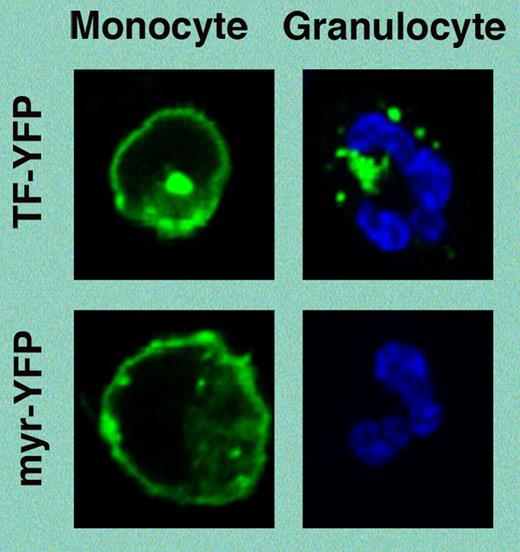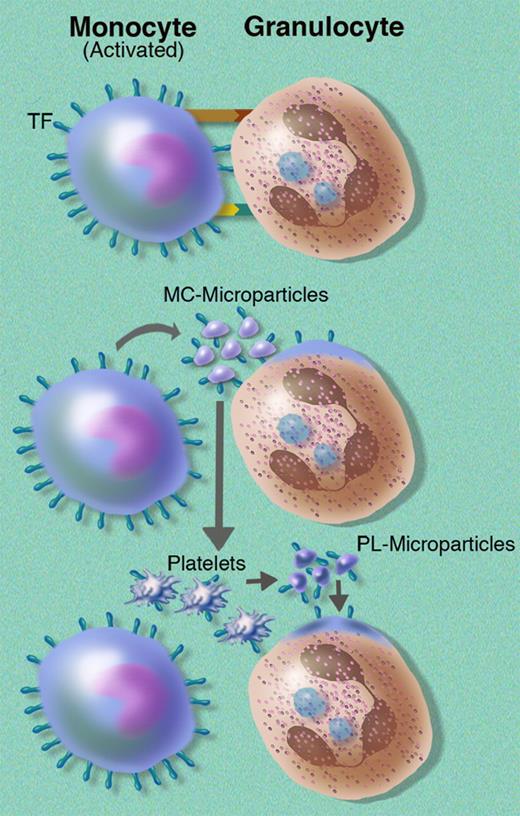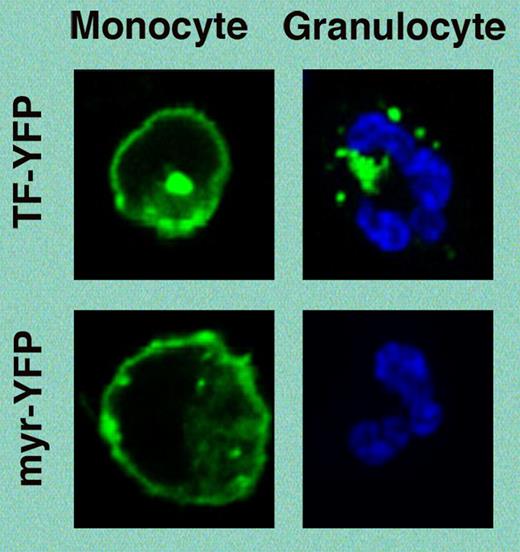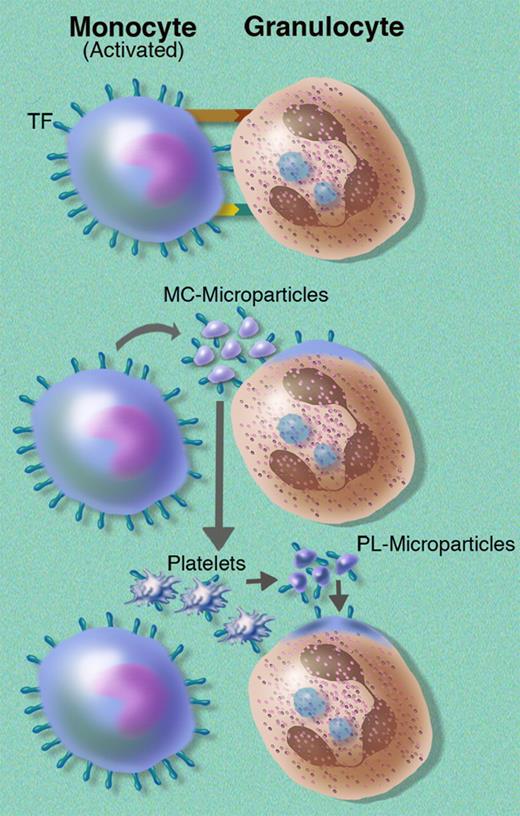The presence and origin of tissue factor (TF) in granulocytes is controversial. In this issue of Blood, Egorina and colleagues provide compelling evidence that granulocytes do not express TF but that they acquire it from monocytes.
There is unanimous agreement in the clotting research field that monocytes express TF upon bacterial infection and probably in other disease conditions. In contrast, there is passionate disagreement over whether granulocytes also express tissue factor (TF).1,2 A number of studies since the 1970s have reported TF expression in neutrophils and other granulocyte populations under a variety of experimental conditions. Neutrophils are differentiated from the same common progenitor as monocytes. In such closely related cell lineages, DNA methylation of promoter regions is thought to be responsible for differential gene regulation. The DNA methylation status of the CpG islands in the TF promoter region appears to be the same in both neutrophils and monocytes; in other words, there is no methylation. Therefore, it is possible that the TF gene could be transcribed in neutrophils upon stimulation, as it is in monocytes. However, the concept of granulocytes expressing TF was justifiably questioned.2 Geisen et al3 used immunohistochemical means to show the presence of TF-bearing neutrophils where native human blood was perfused over pig arterial media or collagen-coated slides. Their findings reignited the debate on the presence of TF in neutrophils, its source, and its significance.
In this issue of Blood, Egorina and colleagues provide convincing and solid experimental evidence that granulocytes do not synthesize TF but that they acquire it from monocytes. In a sense, the present finding is not really novel, since this group showed similar results earlier using different methodology. Actually, the idea that neutrophils do not express TF has been the group's mantra for many years. The importance and significance of the present study lie in its convincing nature and the elegance by which the authors established the finding. This study eliminated all previous ambiguities in evaluating whether granulocytes express TF or acquire it from other sources. The methodology used here circumvented earlier difficulties associated with the introduction of siRNA or plasmid DNA into freshly isolated leukocytes and may become quite useful in the field for elucidating specific functions of leukocyte-associated proteins with certainty.
Egorina et al show that the reintroduction of mononuclear cells transfected with si-TF RNA into whole blood reduced TF activity and antigen levels not only in monocytes but also granulocytes upon LPS stimulation. In contrast, the introduction of si-TF RNA to granulocytes and their subsequent reconstitution into whole blood had no effect on TF levels in either granulocytes or monocytes. These data clearly establish that granulocytes do not express TF and also suggest that TF antigen may be transferred from monocytes to granulocytes. Detection of a TF-YFP fusion protein in granulocytes in whole blood upon reconstitution of the blood with immunologically isolated monocytes that overexpress TF-YFP provided elegant direct evidence for the transfer of TF from monocytes to granulocytes (Figure 1). Interestingly, this transfer appears to be specific to TF, since membrane-targeted myr-YFP introduced to the monocytes was not transferred to granulocytes (Figure 1). It is somewhat surprising to see that most of the transferred TF is not on the outer cell membrane but is localized intracellularly, and it will be interesting to examine whether this TF pool is translocated to the surface upon specific activation of granulocytes. One small deficit is that this paper does not shed any light on the TF transfer mechanism. It is possible, as the authors note, that the fusion of monocyte-derived microparticles containing TF with granulocytes might be the mechanism. Alternatively, direct cell-to-cell contact between monocyte and granulocyte or transfer of monocyte-derived particles first to platelets and then to granulocytes could also be responsible for the transfer of TF from monocytes to granulocytes (Figure 2).
Granulocytes acquire TF from monocytes. Monocytes from blood were isolated and transfected with TF-YFP or myrisylated YFP (myr-YFP) and reintroduced to whole blood (adapted from Egorina et al in the article beginning on page 1208).
Granulocytes acquire TF from monocytes. Monocytes from blood were isolated and transfected with TF-YFP or myrisylated YFP (myr-YFP) and reintroduced to whole blood (adapted from Egorina et al in the article beginning on page 1208).
Potential pathways of TF transfer from monocytes to granulocytes. Granulocytes could acquire TF from monocytes by direct contact (top), fusion with monocyte-derived microparticles (middle), or fusion with platelet-derived mircoparticles containing monocyte-derived TF (bottom). MC indicates monocyte-derived; PL, platelet-derived.
Potential pathways of TF transfer from monocytes to granulocytes. Granulocytes could acquire TF from monocytes by direct contact (top), fusion with monocyte-derived microparticles (middle), or fusion with platelet-derived mircoparticles containing monocyte-derived TF (bottom). MC indicates monocyte-derived; PL, platelet-derived.
The present study solves the mystery of TF presence in granulocytes, definitively establishing that granulocytes do not synthesize TF but acquire it from monocytes. Perhaps it is time for us to reexamine whether TF found in platelets, eosinophils, or other blood cells is actually synthesized in situ or whether it is acquired from monocytes in these cases as well.
Conflict-of-interest disclosure: The author declares no competing financial interests. ■





